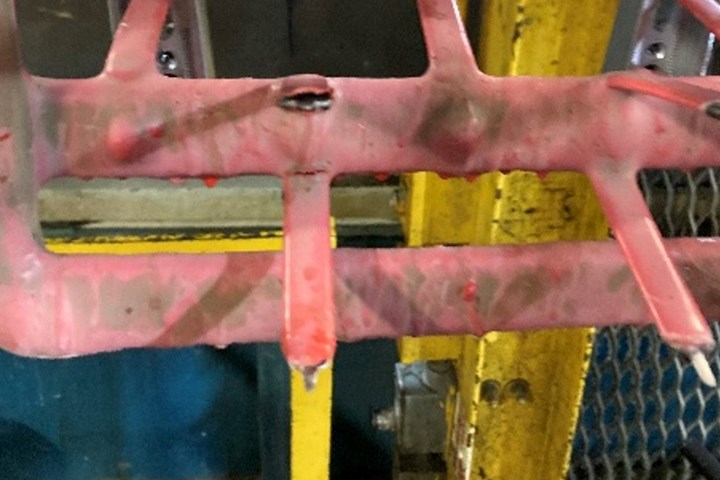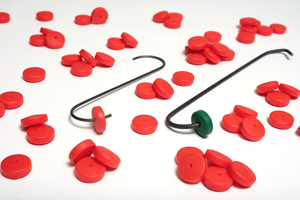The Importance of Rack Maintenance
A look at how poor rack maintenance contributes to wasted time, wasted chemicals and wasted materials.

Poorly maintained racks can contribute to part defects and contaminate your plating solutions with the tramp metals from the rack itself.
Photo Credit: MacDermid Enthone
The term “maintenance” rarely conjures even a modicum of excitement from anyone in any field, be it surface finishing, medical or janitorial. Whether it’s maintenance for your car, your washing machine, or, if you are a denizen of the plating world, for a tank, a pump, or a rack, maintenance is decidedly insipid.
As tedious and mundane as the work associated with maintenance is, be it cleaning, stripping, preserving, or refurbishing, we all should come to recognize how crucial and indispensable this seemingly inconsequential and prosaic process is to the functioning of the whole, no matter what industry we support.
Peering into a fairly-average-plating shop, processing a fairly-average-sized part, on a fairly-average-line, will produce a rack that can hold maybe 24 pieces, with three parts racked on each row and four rows total on each side, back and front. Part spacing and part density depend largely on the type of plating conducted. For instance, chromium plating of either the hexavalent or trivalent variety requires demonstrably more spacing than other types of plating, like alkaline zinc, for instance, due to chrome’s notoriously poor macro- and micro-throwing and covering power or the inability to plate into the low current density areas and distribute thickness uniformly. Let’s assume our hypothetical “fairly-average” plating shop has not maintained their racks as well as they ought and so the rack tips cannot manage to hold all 24 parts. Even a handful of missing parts is automatically cutting down on potential productivity by 20% or more. The plating manager is then forced to work his crew an extra two hours, with possible time-and-a-half overtime pay for an 8-12-hour shift to plate the same number of parts.
Missing parts due to poor rack tip maintenance will also detrimentally impact the other parts being plated. Platers don’t generally have the means to adjust their rectifiers to achieve a certain current density for each different type of rack being processed through the line. Oftentimes, there is only one rectifier for one tank with multiple bays/cells, although some shops recently have adopted dedicated rectifiers for each bay. Most shops have not appropriated these innovative rectifier modifications and are therefore subject to the travails of appealing to the lowest common denominator.
If, for instance, in our fairly-average shop, one rack has half its intended parts (12) and another rack following directly after has 75% of its parts (18) and a third has all its parts (24), we are going to have some variability. Because the amperages cannot be individually adjusted for each rack’s square footage, we will be exposing these racks to different current densities. All baths are assigned with an optimal current density range and depending on the geometry and orientation of the parts undergoing the deposition reaction each part will produce an acceptable coating in each current density region on both a macro- and microscopic level provided not only the current density is within the proper range, but also the other parameters and features of the plating operation are tightly controlled. These include pH, temperature, agitation rate, contaminant level, concentrations, etc. If the bath constituents both proprietary and non-proprietary are tightly controlled, the current density window would therefore be permitted to widen, but since many, if not most, plating shops operate within fairly loose and casual boundaries of control, the chances are low that a standard electroplating solution can afford to exceed the current density limitations and restrictions without being subjected to rejects.
Therefore, the rack with half the parts may be subjected to excess current density which causes burning, exfoliation, pitting, and roughness, the rack with ¾ of its intended parts may be within the specification and cosmetic limits because it is maybe between the lowest and correct number of parts, but the full rack of parts may not receive an adequate thickness, depending on the current density being applied and the adjustments made to compensate for the least common denominator. This rack may also be subject to low current density issues related to tramp metal plate-out along with other deleterious effects.
These failures require a strip and replate or possibly a complete do-over with new parts while the scrap pile continues to grow. This amounts to wasted time, wasted chemicals, wasted metal, wasted material, and other ancillary waste. Due to current density discrepancies, the deposit will now be different from rack to rack, creating irregularities and inconsistencies relating to cosmetics or aesthetics, hardness, ductility, stress, thermal stability, conductivity, resistivity, and other features and benefits expected from the deposit.
Beyond poor rack tip maintenance, the racks themselves are often riddled with large holes and tears in the Plastisol or PVC-resin coating. This will not only cause a deterioration of the rack as it is being attacked by several different plating solutions from the highly alkaline to the highly acidic, but will also pollute and contaminate those solutions with the tramp metals from the rack itself. Additionally, this can cause severe plate-up of the rack, which again, wastes chemistry and metal and increases the potential for roughness, pitting, adhesion failure, and overall cosmetic quality deficiencies because those metallic nodules, dendrites and fines are weakly adherent and often slough off and incorporate themselves into the deposit as occlusions. Those fissures and rips in the Plastisol are also subject to capillary action wherein solution is suctioned or siphoned up like a finger on the end of a straw in a cup of water. This liquid then releases itself into other solutions as temperature fluctuates throughout the processing cycle.
Oftentimes the rack tips can conduct adequate current, but do not hold the parts correctly and often will tilt or orient themselves in such a way that the anode-to-cathode spacing is dramatically different from the way the system was initially designed, assuming parts had a predictable and consistent anode-cathode spacing. Without accounting for these incongruities, the parts will receive an excessive amount of current or a type of deposit that is far from the ideal as established initially, which will contribute mightily to the magnitude of rejects.
Maintenance may not be the most exciting part of the magic of plating, but it is certainly non-negotiable and clearly will pay dividends with only a pinch or sliver of deliberate effort. Improvements to deposit quality, consistency, and uniformity, coupled with improvements to labor, chemical, and material savings more than justify the pain and displeasure of embarking on the daily grind of ensuring your racks are functioning as they ought.
About the Author

Adam Blakeley
Adam Blakeley is Director of Eastern Region Technical Services for MacDermid Enthone Industrial Solutions. Visit industrial.macdermidenthone.com.
Related Content
Film Thickness Control
Have a powder coating job that requires precise film thickness control? Products Finishing columnist Rodger Talbert offers advice controlling the variables that can impact your success.
Read MoreTroubleshooting 5 Common Racking Problems for Platers
Being aware of usual issues that might occur during the plating process will prepare platers by helping them know how to avoid them all together or how to fix them if they happen.
Read MoreCFS Unveils New Hook Locks Parts Racking Solution
New product from Custom Fabricating & Supplies (CFS) prevents part loss during coating processes.
Read MoreFABTECH 2024 Heads to Orlando
CCAI’s FINISHING Pavilion and Conference continues to grow at FABTECH, offering insights and innovations covering all aspects of industrial surface finishing.
Read MoreRead Next
Electrolytic Rack Stripping Best Practices
J.R. Eyerly of Haviland Enterprises discusses the benefits of switching to an electrolytic strip from a nitric-based nickel strip for rack stripping, as well as best practices to ensure desired results.
Read MoreRacking and Conveyor Automation Solutions
Considerations for automating various operations within a finishing system.
Read MoreThe Real Cost: C-Hooks Versus Parts Racks
Industrial finishing line consultant Dan Davitz discusses the advantages of parts rack over the use of C-hooks for your paint or powder coating line.
Read More





















